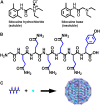Enhanced Antitumor Activity of Lidocaine Nanoparticles Encapsulated by a Self-Assembling Peptide
- PMID: 35529446
- PMCID: PMC9068872
- DOI: 10.3389/fphar.2022.770892
Enhanced Antitumor Activity of Lidocaine Nanoparticles Encapsulated by a Self-Assembling Peptide
Abstract
Although local anesthetics (LAs) such as lidocaine have been traditionally used for pain relief, their antitumor activity has attracted more and more attentions in recent years. However, since nearly all LAs used in clinic are in their hydrochloride forms with small molecular weight and high water-solubility, their fast absorption and clearance greatly limit their antitumor activity in vivo. To better exploit the antitumor activity of LAs, lidocaine nanoparticles (LNPs) are prepared by using a self-assembling peptide to encapsulate the hydrophobic base form of lidocaine. In cultured A375 human melanoma cells, the LNPs show much higher cellular uptake level than the clinic formulation of lidocaine hydrochloride, which leads to enhanced efficacy in inhibiting the proliferation, migration and invasion of the cells, as well as in inducing cell apoptosis. Compared with lidocaine hydrochloride, LNPs can also significantly slow down the release rate of lidocaine. In nude mice, LNPs can effectively inhibit the development of solid tumors from seeded A375 cells and prevent the recurrence of tumors after surgical excision. These results indicate that by using self-assembling peptide to fabricate nanoparticle formulations of local anesthetics, their antitumor activity can be significantly enhanced, suggesting a potential postoperative treatment to prevent tumor recurrence after surgical excision.
Keywords: antitumor activity; lidocaine; local anesthetics; nanoparticles; self-assembling peptide; tumor recurrence.
Copyright © 2022 Yang, Sun, Peng, Liu, Zhao, Chen, Zhang and Qiu.
Conflict of interest statement
The authors declare that the research was conducted in the absence of any commercial or financial relationships that could be construed as a potential conflict of interest.
Figures








Similar articles
-
Designer self-assembling peptide nanofibers induce biomineralization of lidocaine for slow-release and prolonged analgesia.Acta Biomater. 2022 Jul 1;146:66-79. doi: 10.1016/j.actbio.2022.05.002. Epub 2022 May 8. Acta Biomater. 2022. PMID: 35545185
-
High-Loading Self-Assembling Peptide Nanoparticles as a Lipid-Free Carrier for Hydrophobic General Anesthetics.Int J Nanomedicine. 2021 Aug 11;16:5317-5331. doi: 10.2147/IJN.S315310. eCollection 2021. Int J Nanomedicine. 2021. PMID: 34408412 Free PMC article.
-
Nanocrystals Slow-Releasing Ropivacaine and Doxorubicin to Synergistically Suppress Tumor Recurrence and Relieve Postoperative Pain.ACS Nano. 2023 Oct 24;17(20):20135-20152. doi: 10.1021/acsnano.3c05831. Epub 2023 Oct 8. ACS Nano. 2023. PMID: 37805931
-
The Amide Local Anesthetic Lidocaine in Cancer Surgery-Potential Antimetastatic Effects and Preservation of Immune Cell Function? A Narrative Review.Front Med (Lausanne). 2017 Dec 20;4:235. doi: 10.3389/fmed.2017.00235. eCollection 2017. Front Med (Lausanne). 2017. PMID: 29326939 Free PMC article. Review.
-
A review and new insights to antimicrobial action of local anesthetics.Eur J Clin Microbiol Infect Dis. 2019 Jun;38(6):991-1002. doi: 10.1007/s10096-018-03460-4. Epub 2019 Jan 24. Eur J Clin Microbiol Infect Dis. 2019. PMID: 30680564 Review.
Cited by
-
Advances in the Application of Nanomaterials to the Treatment of Melanoma.Pharmaceutics. 2022 Sep 30;14(10):2090. doi: 10.3390/pharmaceutics14102090. Pharmaceutics. 2022. PMID: 36297527 Free PMC article. Review.
-
Lidocaine attenuates TMZ resistance and inhibits cell migration by modulating the MET pathway in glioblastoma cells.Oncol Rep. 2024 May;51(5):72. doi: 10.3892/or.2024.8731. Epub 2024 Apr 12. Oncol Rep. 2024. PMID: 38606513 Free PMC article.
-
Enantiomeric Excess Bupivacaine in a Lavender Oil NLC Tested in a Melanoma Model: Prolonged Release and Anticancer Effect.Mol Pharm. 2025 Jun 2;22(6):3351-3365. doi: 10.1021/acs.molpharmaceut.5c00254. Epub 2025 May 1. Mol Pharm. 2025. PMID: 40310503 Free PMC article.
References
LinkOut - more resources
Full Text Sources

